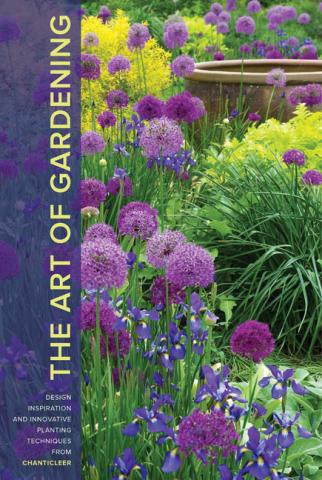
Bill Thomas and the wizard horticulturists at Chanticleer have written The Art of Gardening for us -- dirt gardeners and plant geeks, people who are weak-kneed in the presence of beautiful plants and a compelling landscape. The subtitle is “Design, Inspiration and Innovative Planting Techniques from Chanticleer”, and the book delivers all of that.
Chanticleer is a 35 acre former private estate in Wayne, Pennsylvania, now a public garden with the goal of continuing to be a “pleasure garden”. Nothing about it feels institutional. It has a generous operating budget, a supportive board that focuses on policy matters and fund raising and doesn’t micromanage the horticulture, and a diverse group of horticulturists who each have ownership for a specific part of the garden. Many of them are also talented craftsmen who do metal work, woodwork and pottery. The Executive Director, Bill Thomas, provided the guiding hand for the book, but also included these diverse voices in the text. In his daily role, he acts as the “owner’s representative as well as the head gardener, coach, overseer, and benevolent dictator.” It’s this division of labor and support of individual artistic vision in an orchestrated whole that make Chanticleer such a unique and spectacular garden, with contemporary design in a historic space with traditional architecture. The exceptional photographs are by Rob Cardillo.
The premise of the book is that much of what is done at Chanticleer is easily transferred to the home garden, with ideas about plants as well as design for different types of topography, soil conditions and microclimates. Gardens range from the low maintenance requirements of the Parking Lot and Gravel Gardens, which need little irrigation, to the high maintenance terrace gardens, lushly planted with tropicals requiring daily watering and grooming. This is a large property so there are woodland gardens, meadows, ponds, a cutting garden, extensive perennial borders, a ruin created in the shell of a former house on the estate, and majestic trees. The creativity of the container plantings is worthy of a separate book, but this book provides many examples, with unexpected plants and ideas for seasonal plantings.
In addition to information about plants and their care, we learn a great deal about design principles, planting and propagation techniques. There are also descriptions of things that didn’t work so well so readers can learn from their mistakes and the remedies they devised For example, they fill containers 2/3 of the way with rough compost and top them off with a lighter potting mix. Young plants grow through the light mix into the moisture retentive and nourishing compost, providing ballast as well as nutrition for large container plantings. The Asian Woodland has many stands of bamboo and the gardeners are unapologetic about advising “don’t even think about planting this at home” because its ability to run is undeniable, requiring dramatic measures to keep it in line. The astonishing “flowery lawn”, a beautifully messy meadow, replaced a rectangle of turf in the formal garden near the house. A border of mown turf around this part of the garden signals that it’s intentional.
According to Bill Thomas, plants make Chanticleer the garden it is, and it’s easy to see we are crazed about plants.” There are over 5,000 taxa currently grown in the garden. Plants are ordered from over seventy nurseries each year and the staff are given plants, cuttings, and seeds from fellow plant nuts around the world. Plants that don’t thrive or don’t serve the design well are unsentimentally yanked or relocated. There’s always another great plant to try, an important lesson for those of us who try to shoehorn an admired plant into a less than ideal setting. “By working with our site rather than fighting it, we treat these microclimates as opportunities rather than problems.”
The book closes with a manifesto by Thomas that encourages each of us who garden to garden to please ourselves, and to trust our instincts so that the garden becomes our personal expression. “Gardening is what we do because we must…You cannot serve two masters, nor can your garden. It needs vision and a strong leader to be good.”
Alicia Whitaker is a new member of the Manhattan chapter of NARGS. She gardens in the Hamptons and chairs the garden committee of her NYC coop. She is writing a book about the blooming of the NYC streetscape with photographer Betsy Pinover Schiff.
